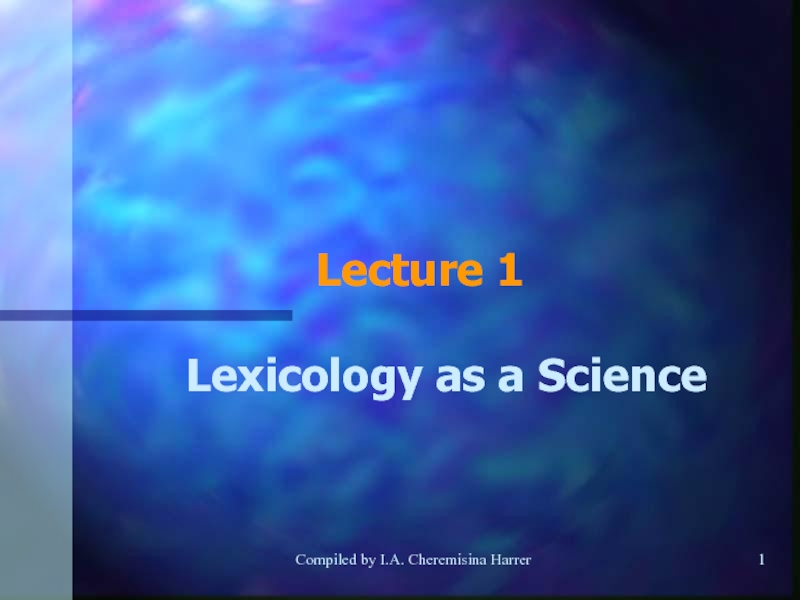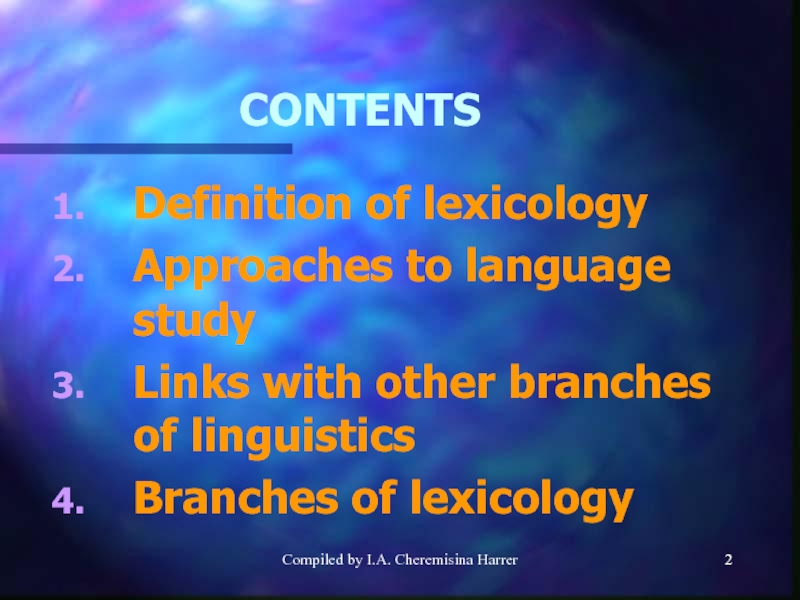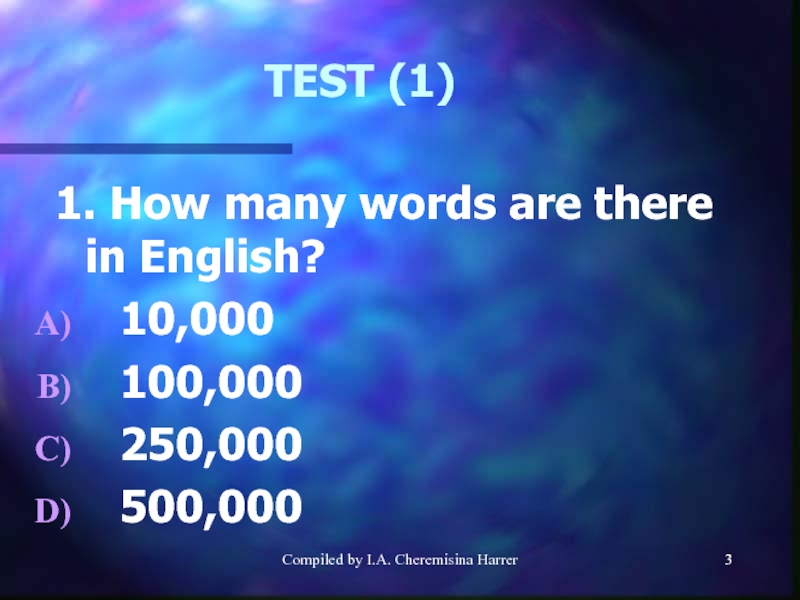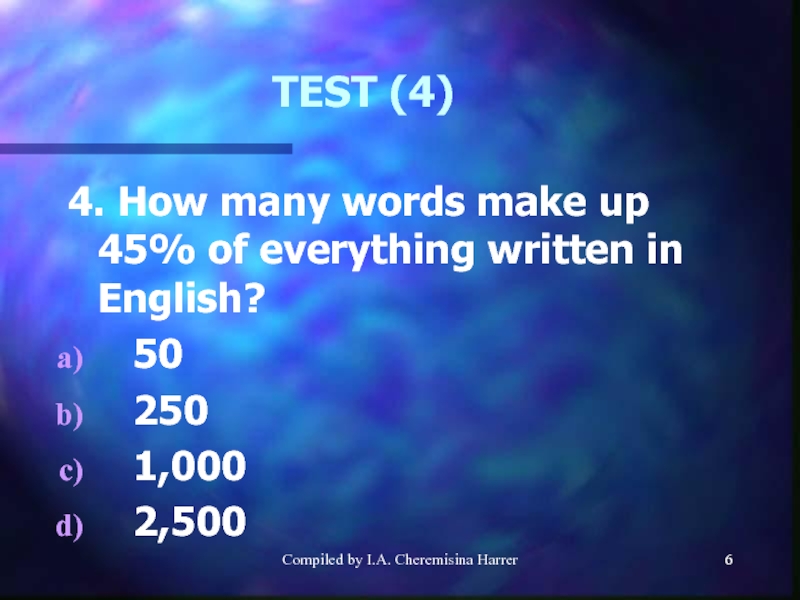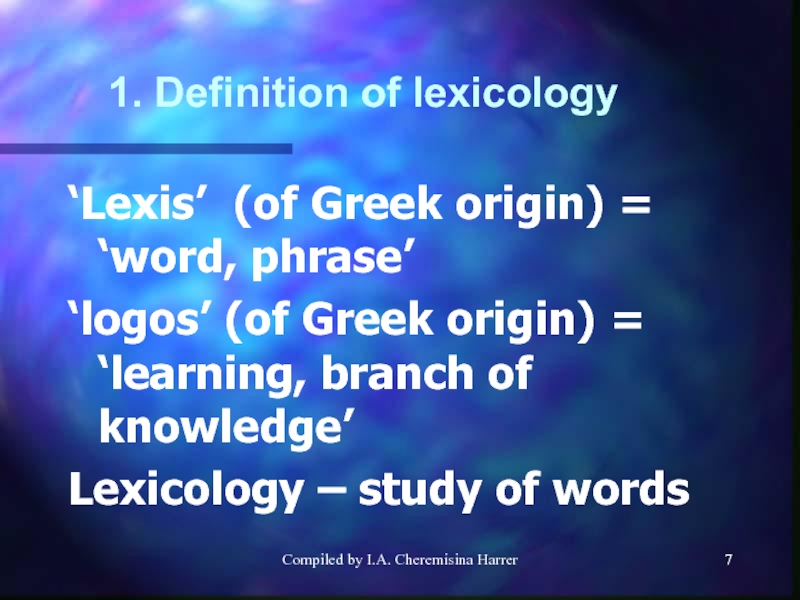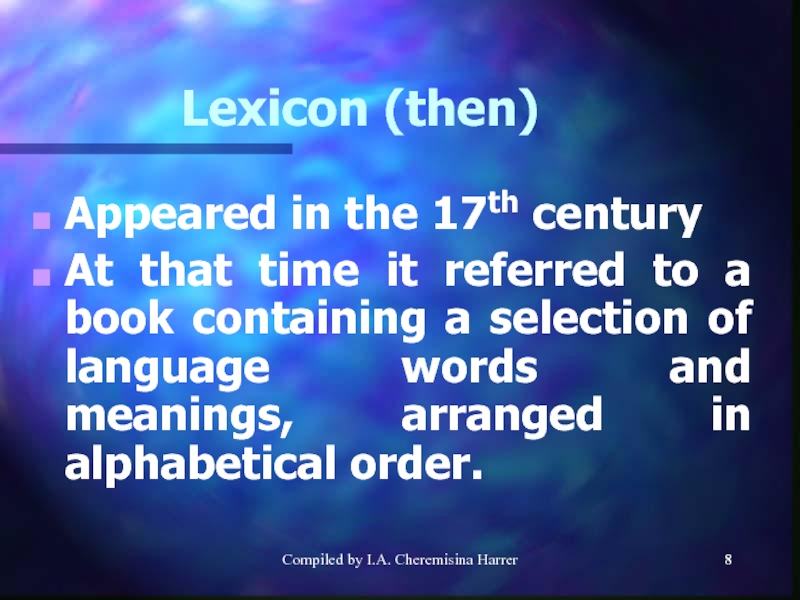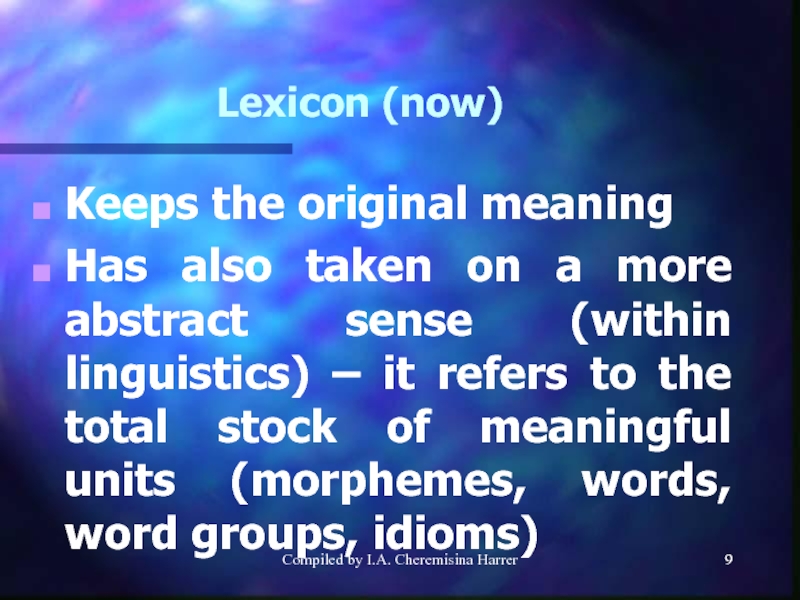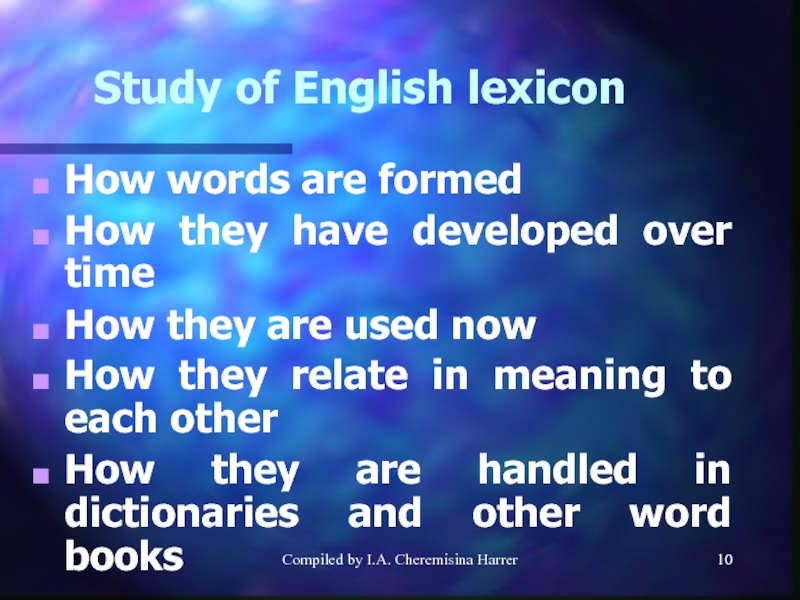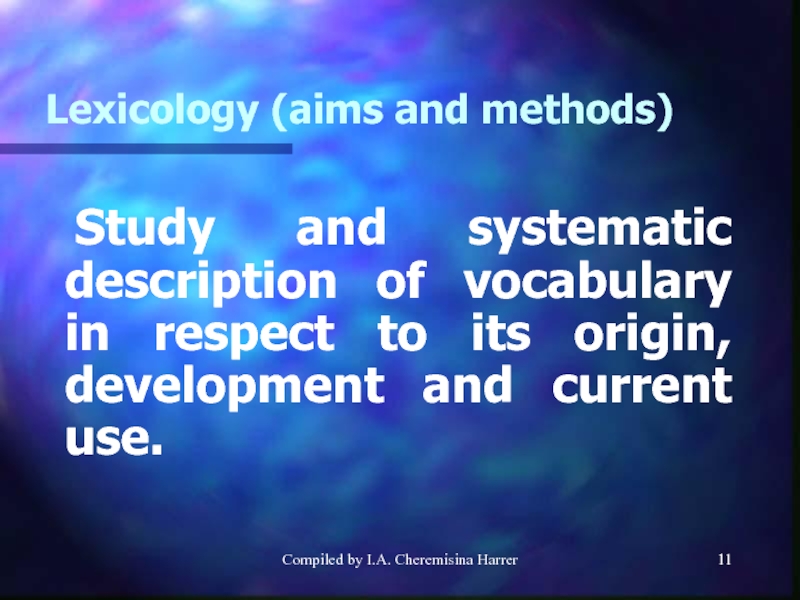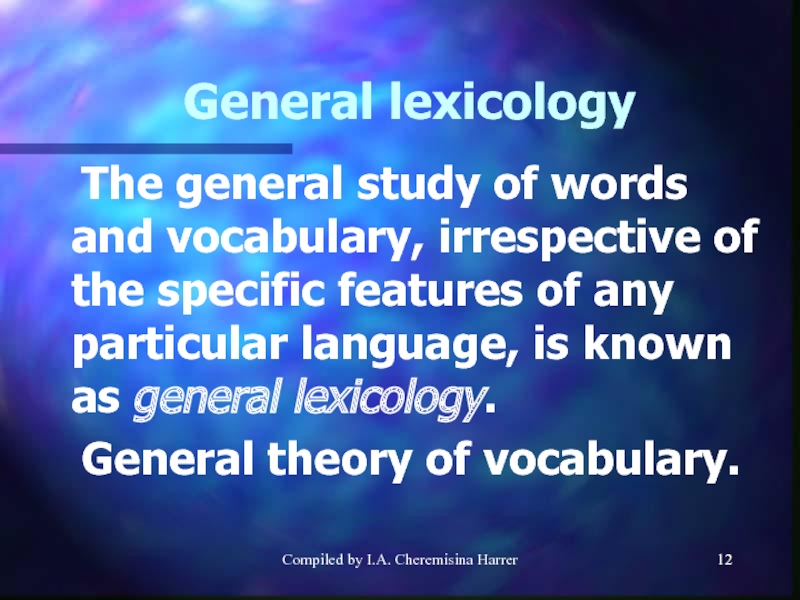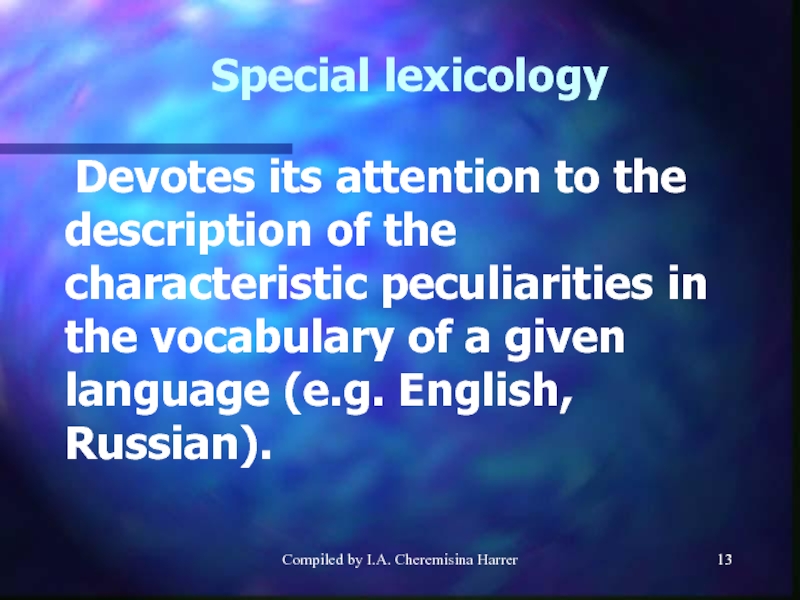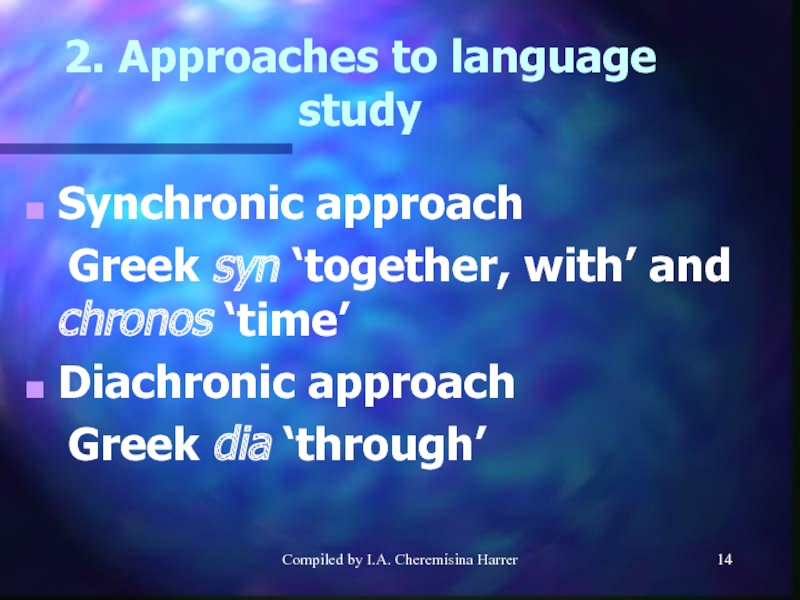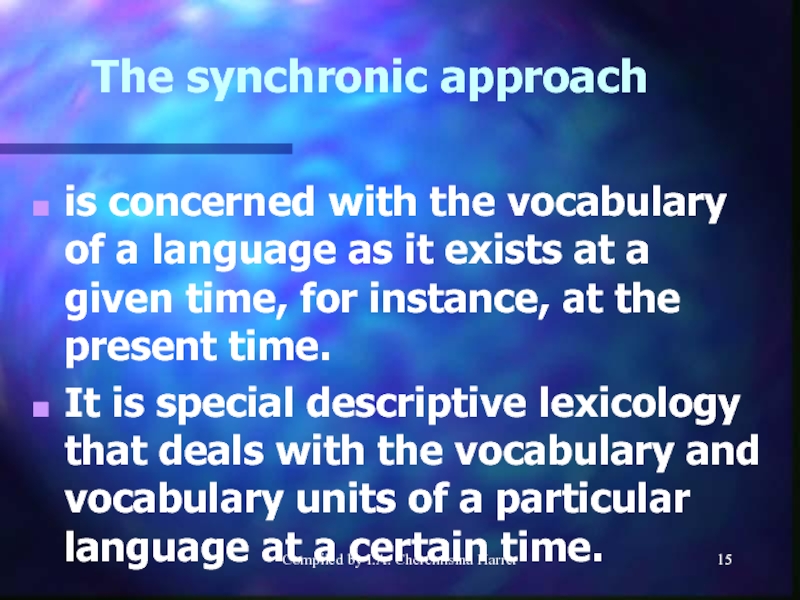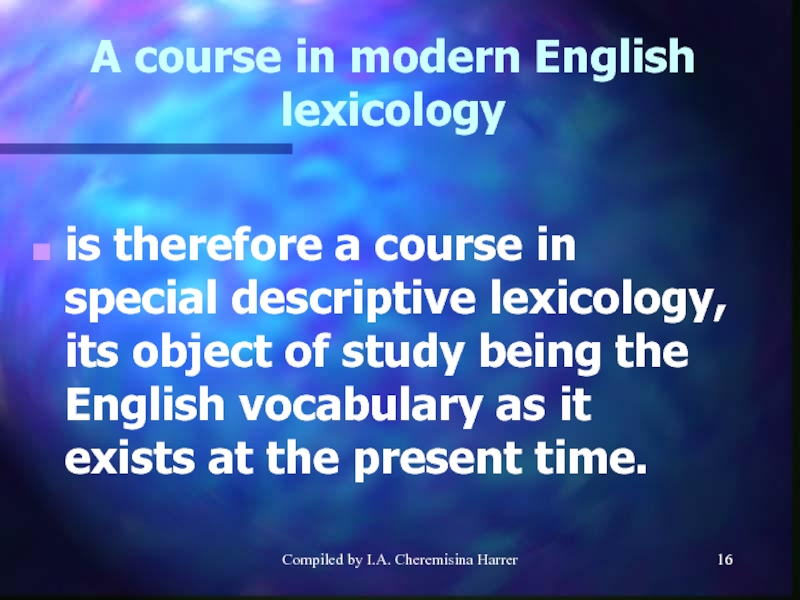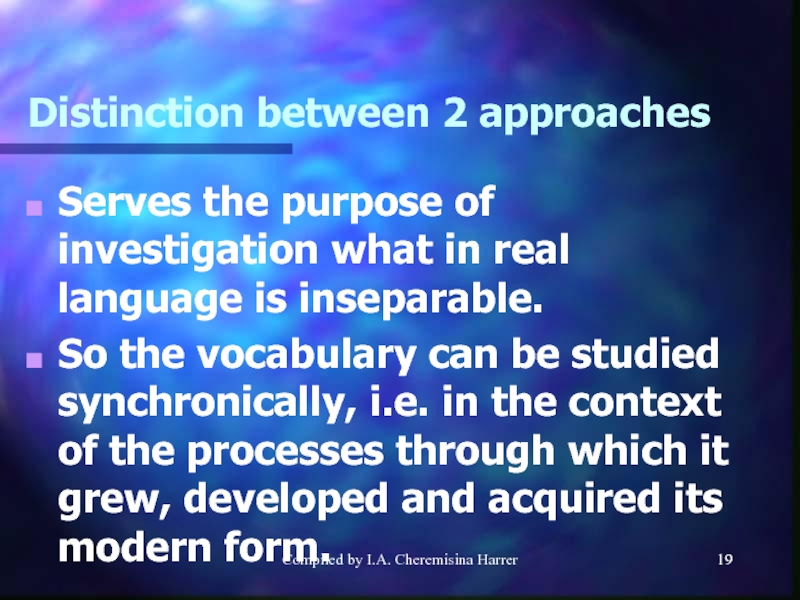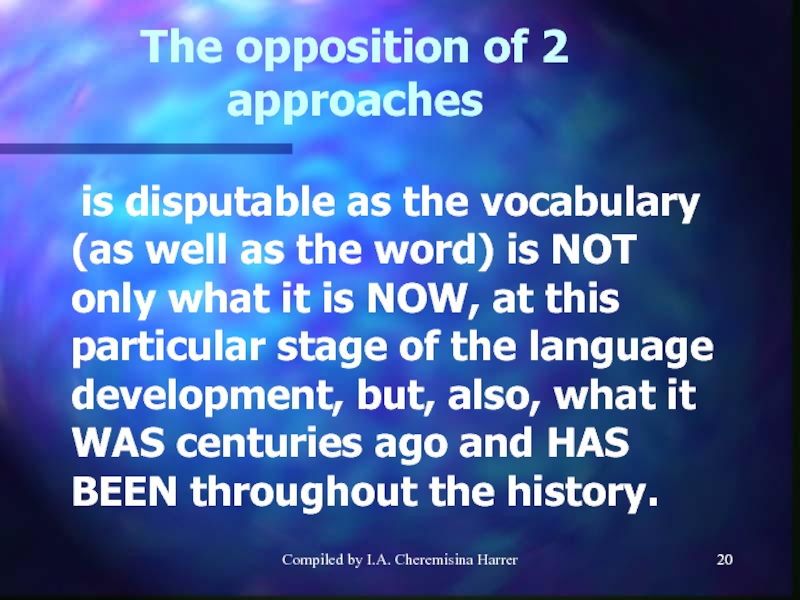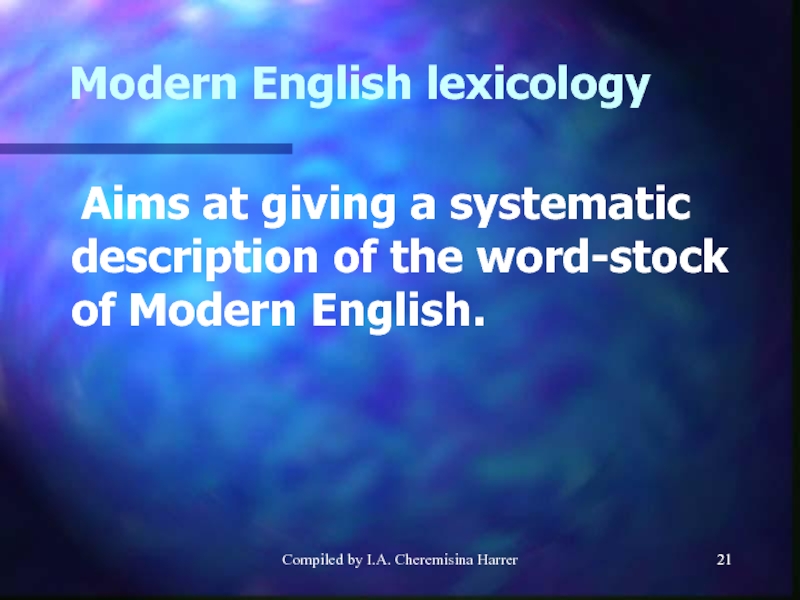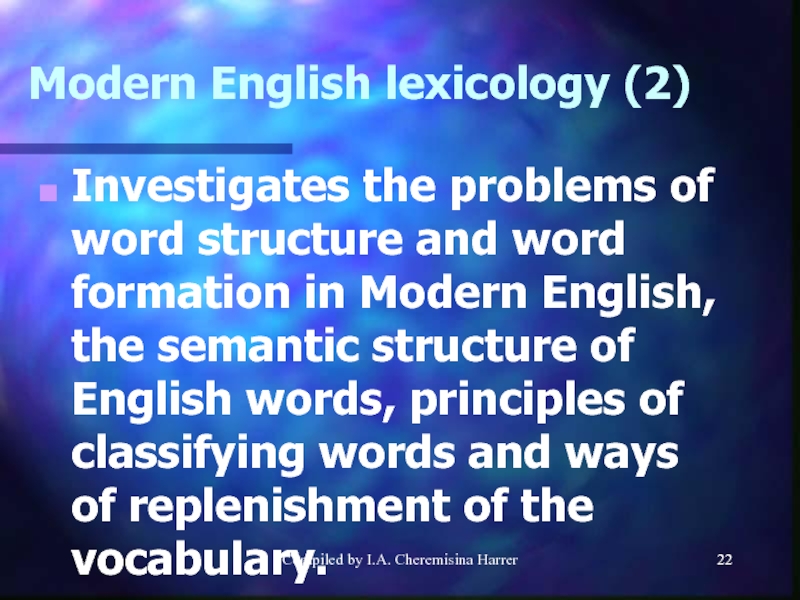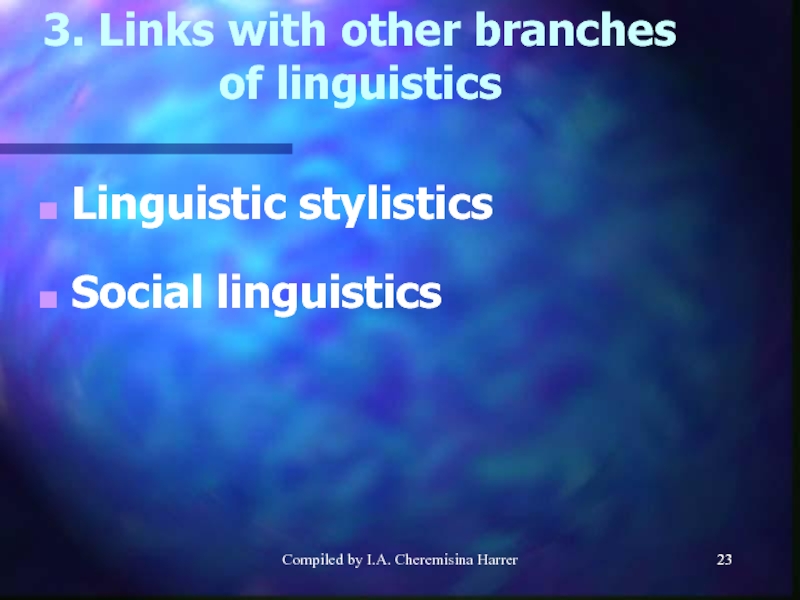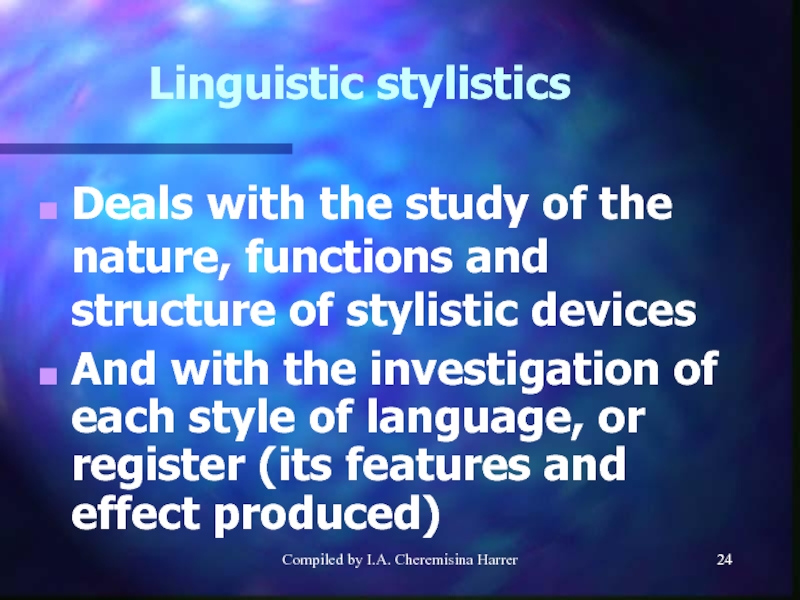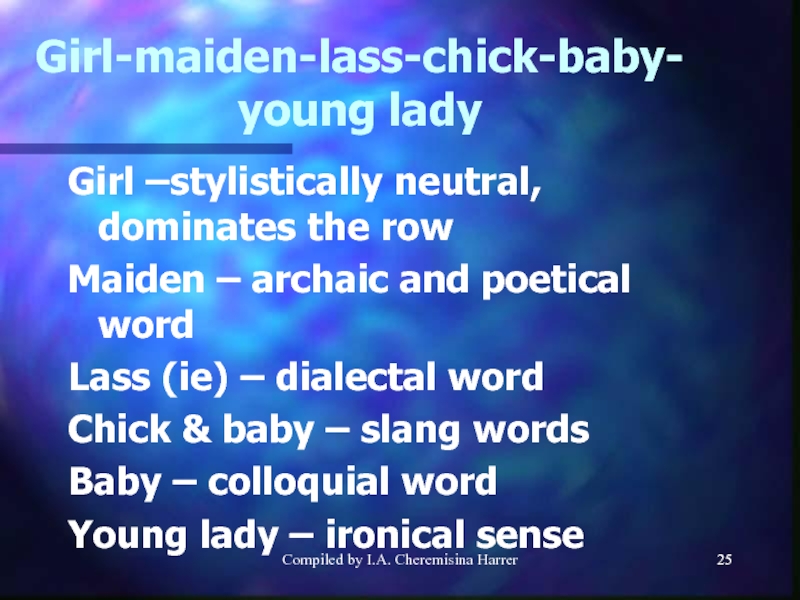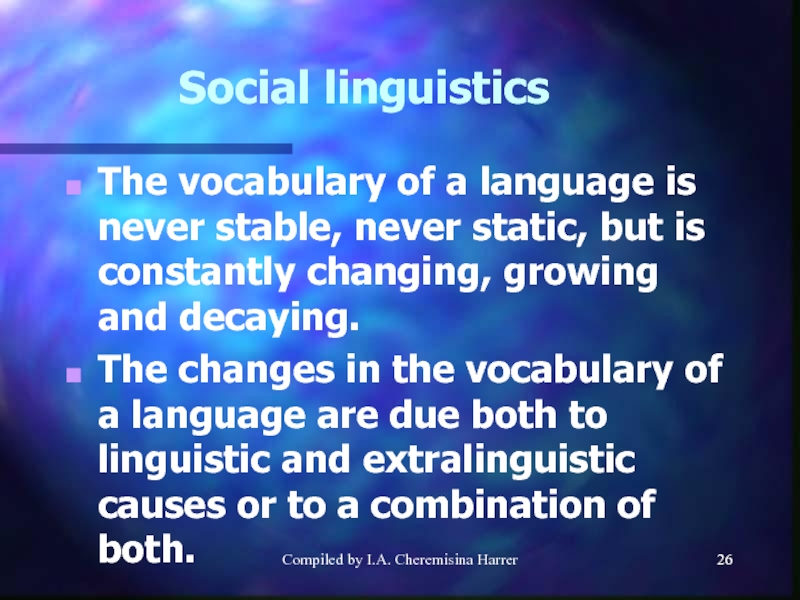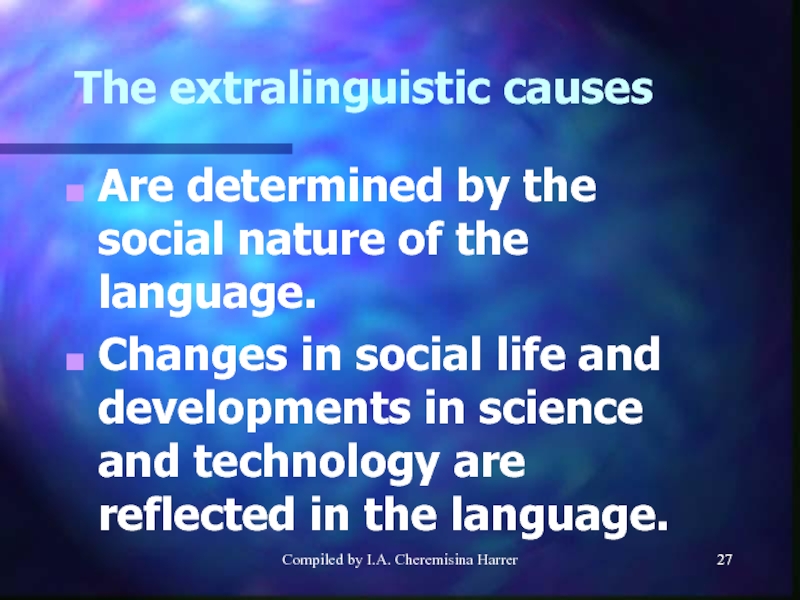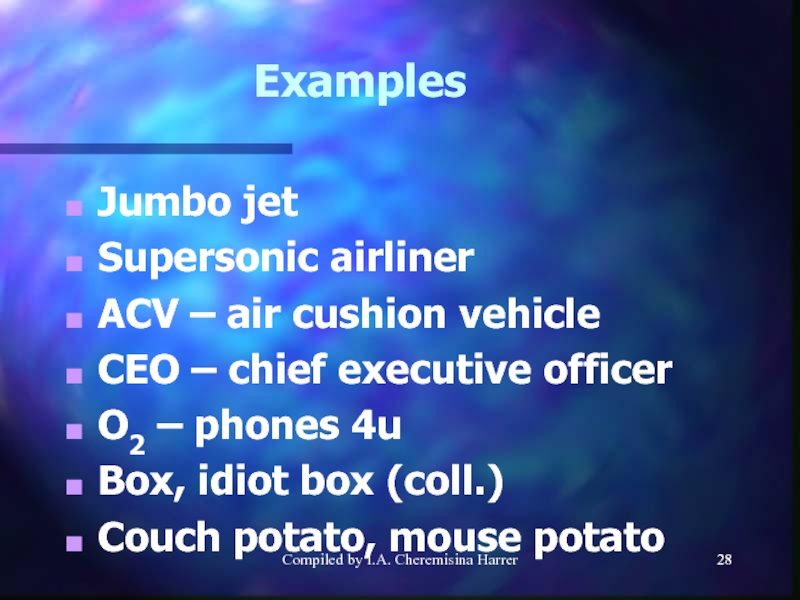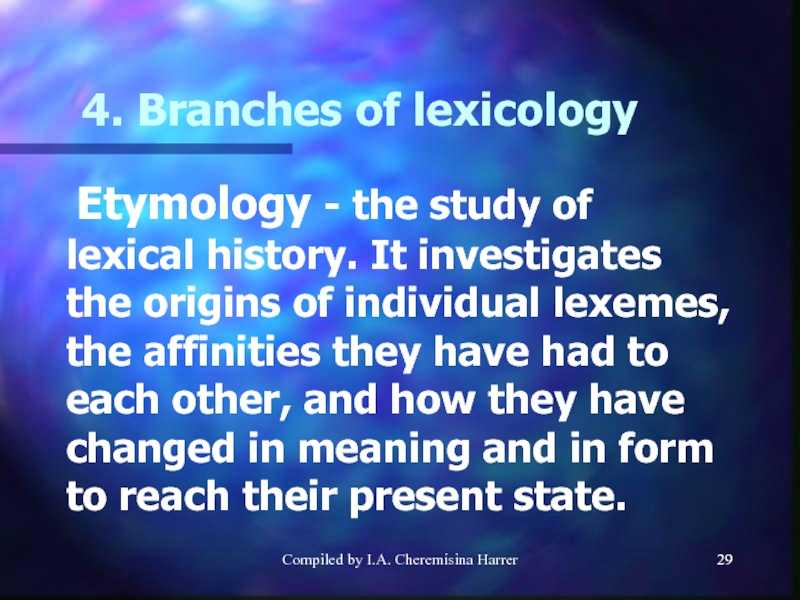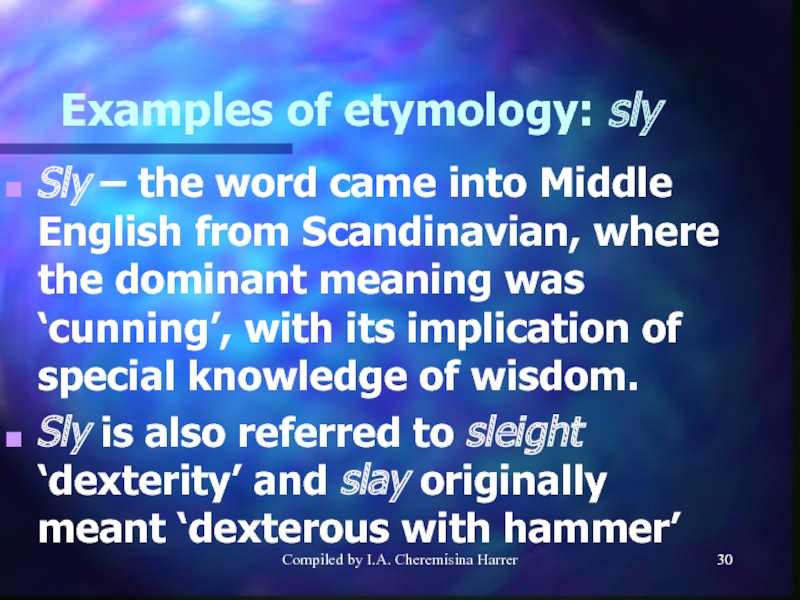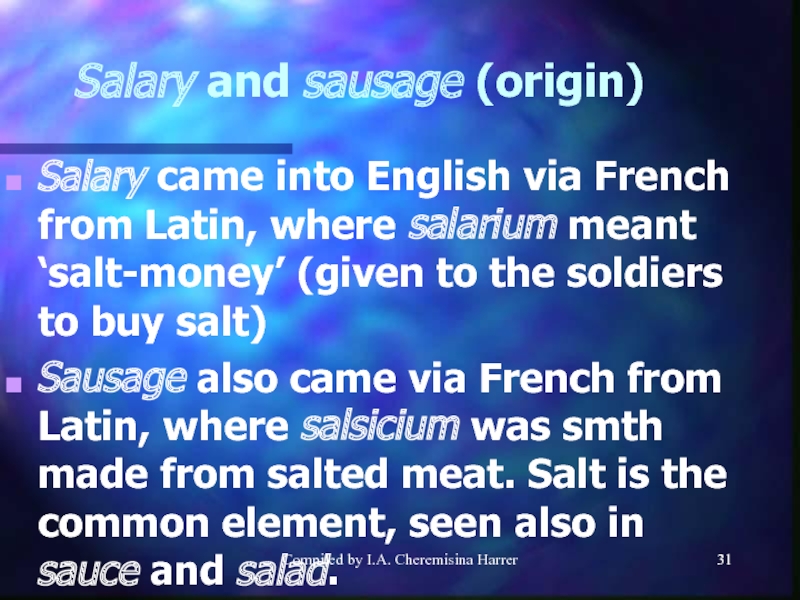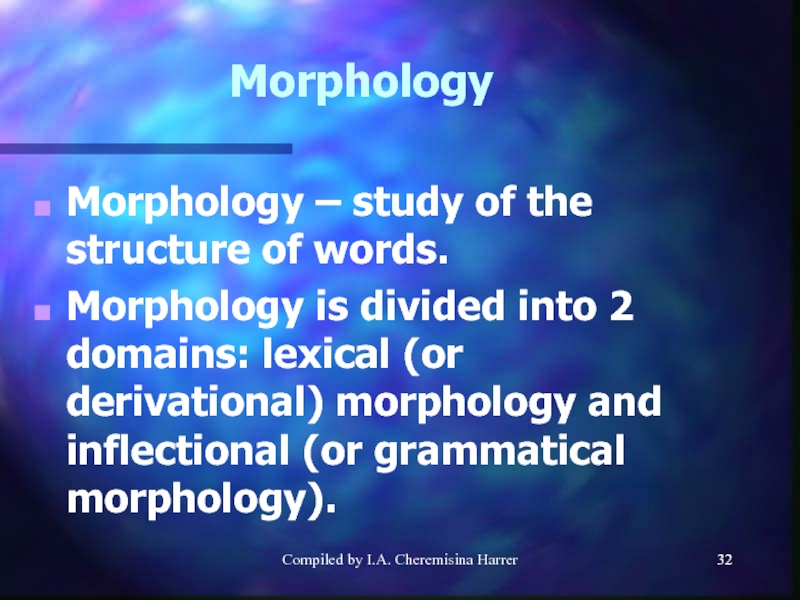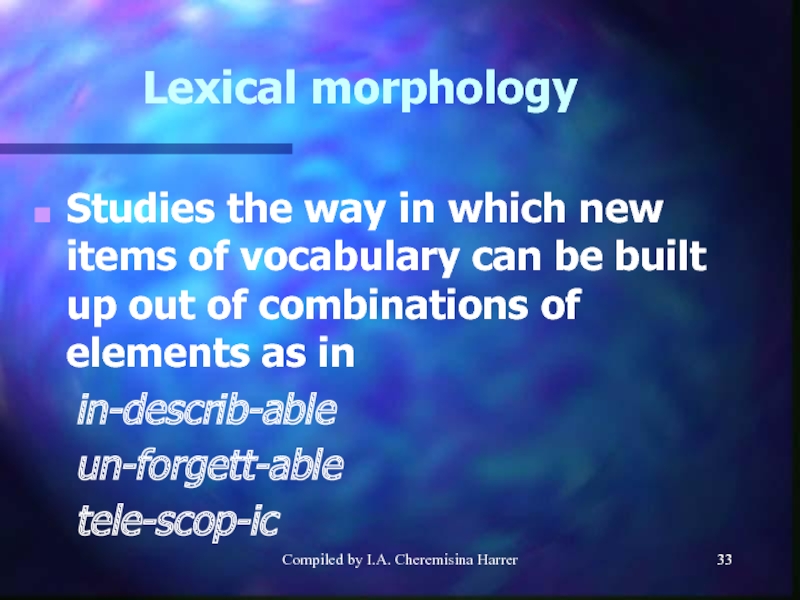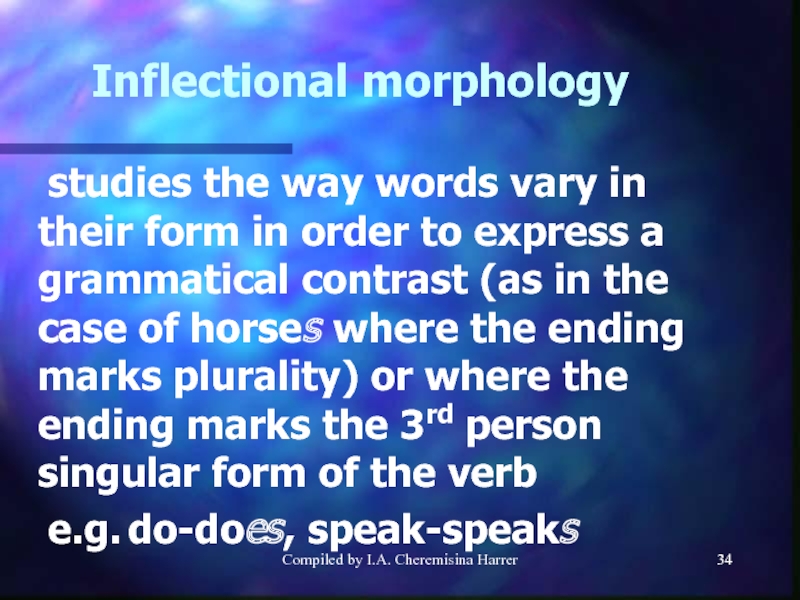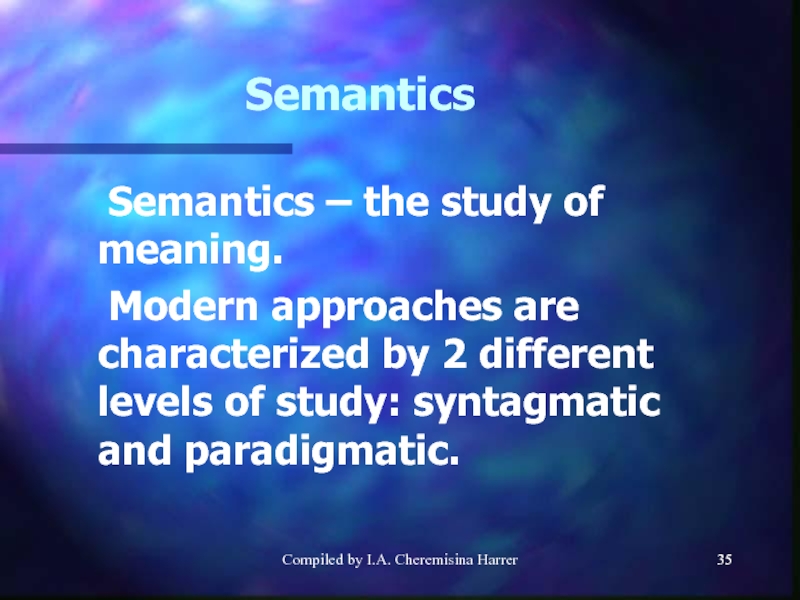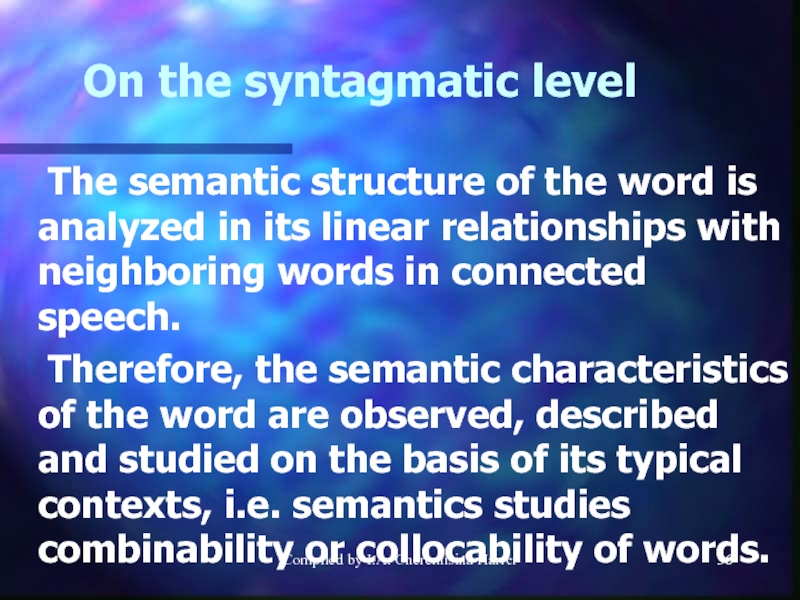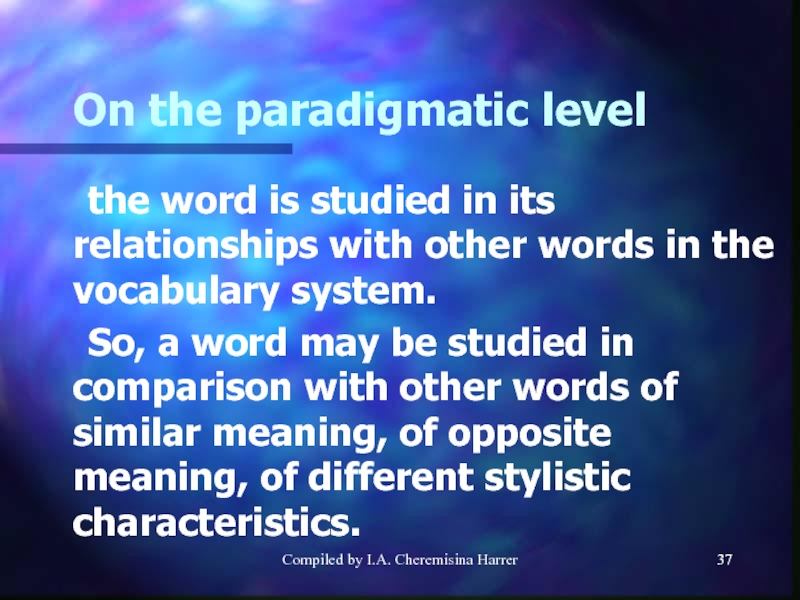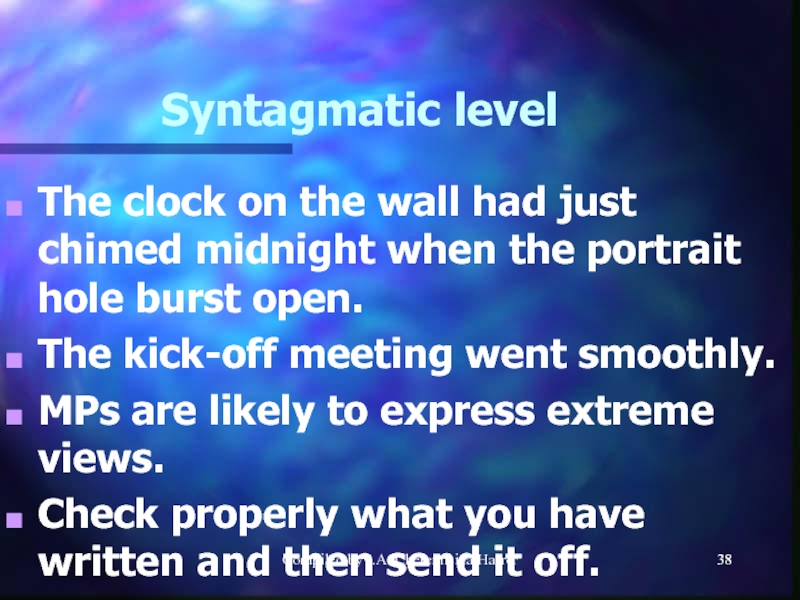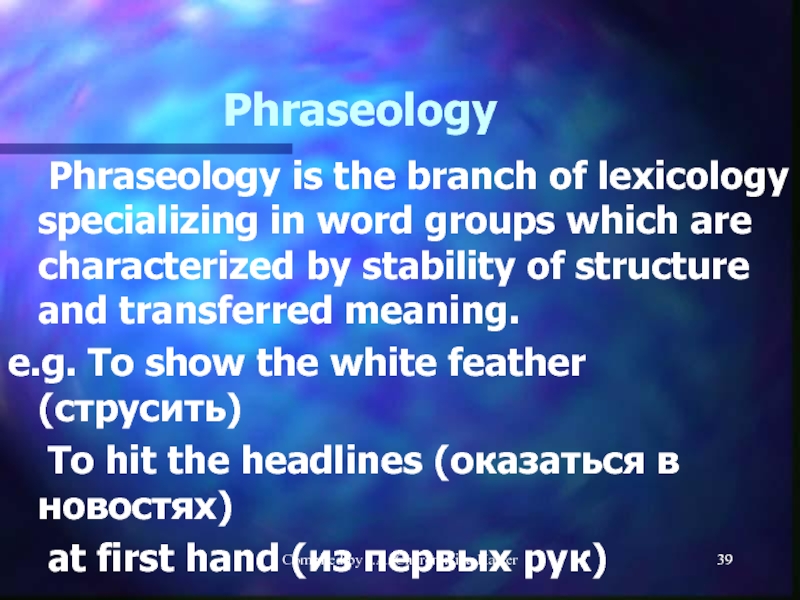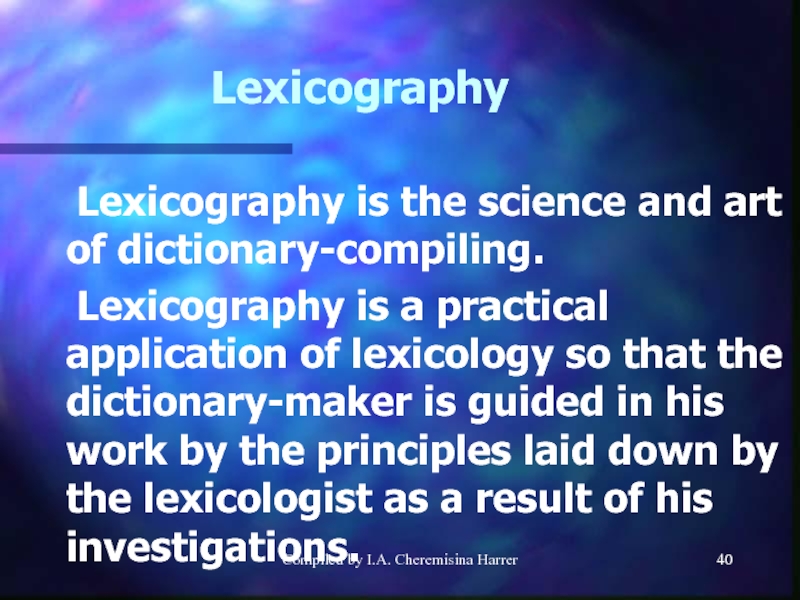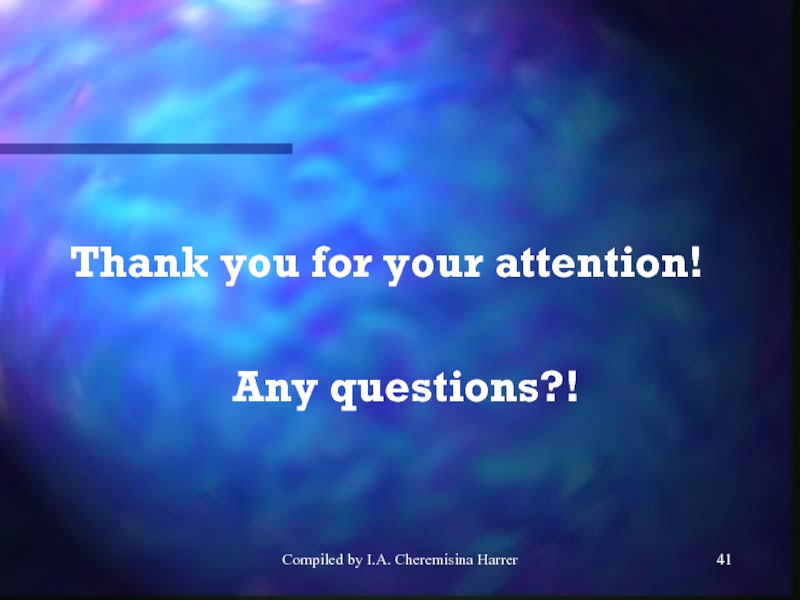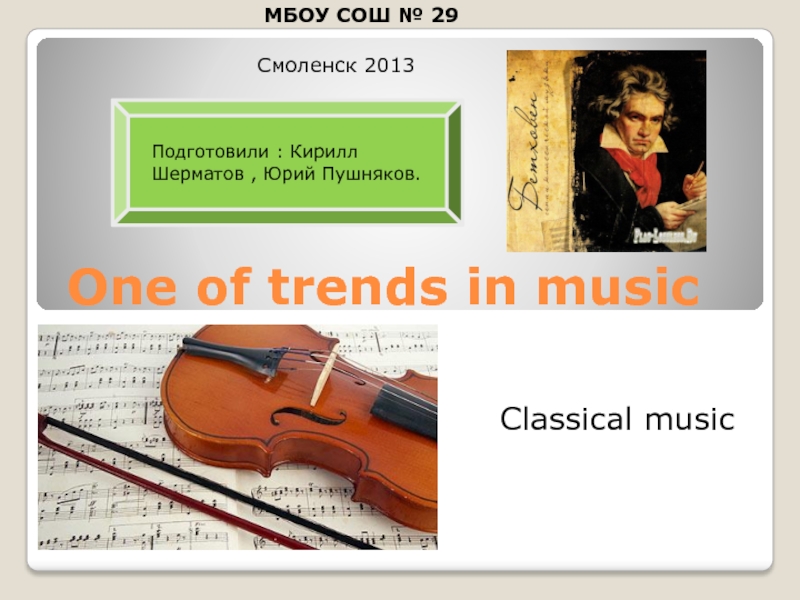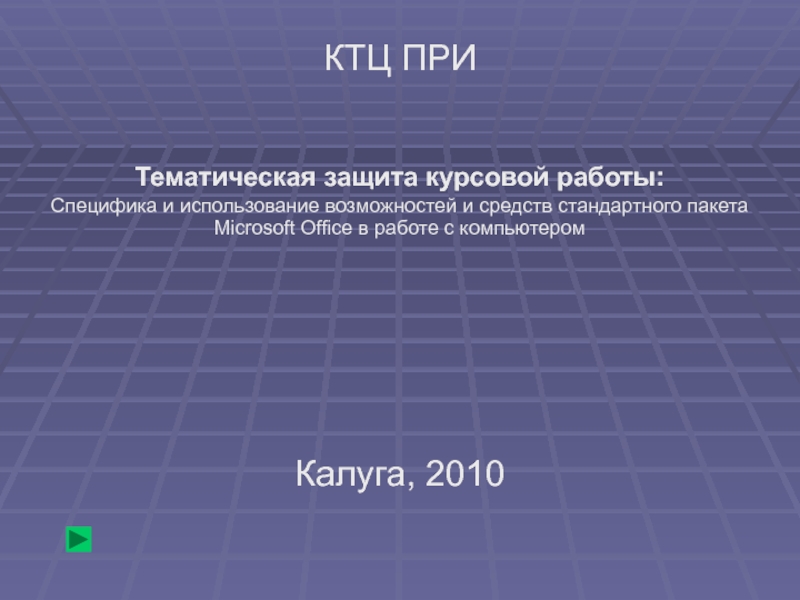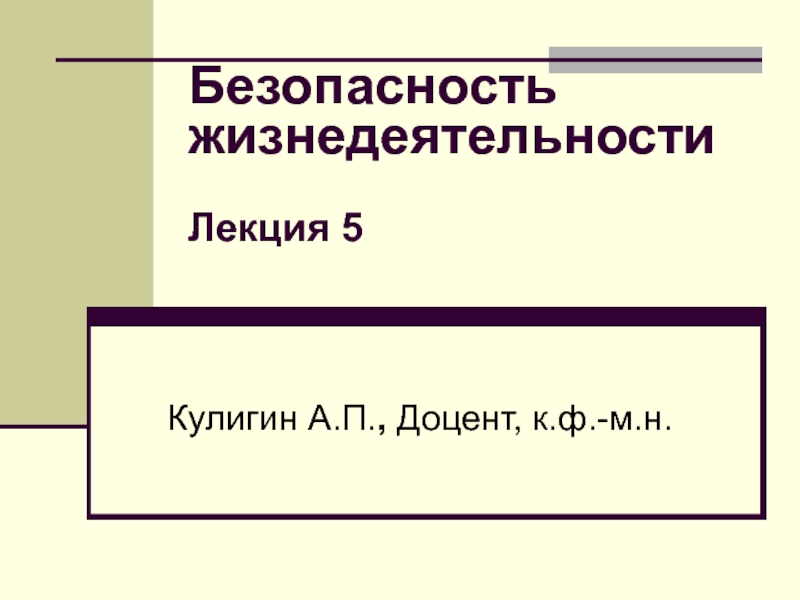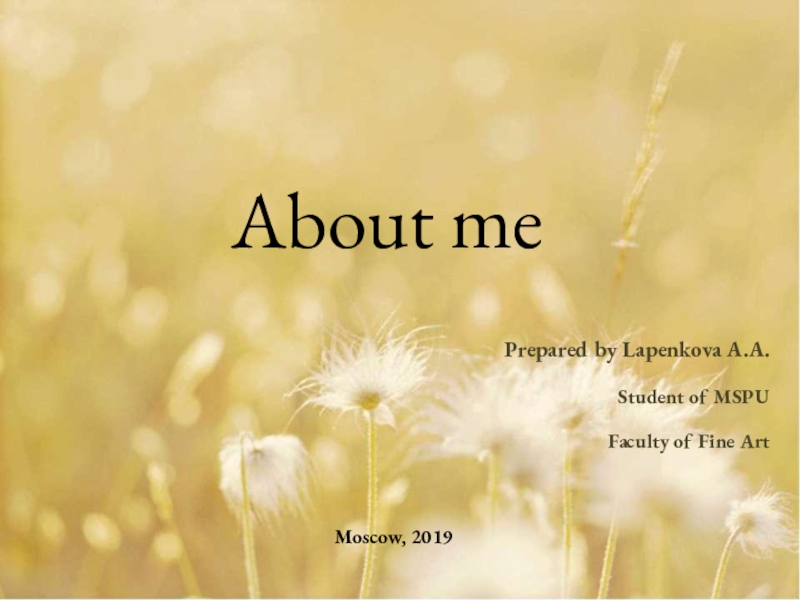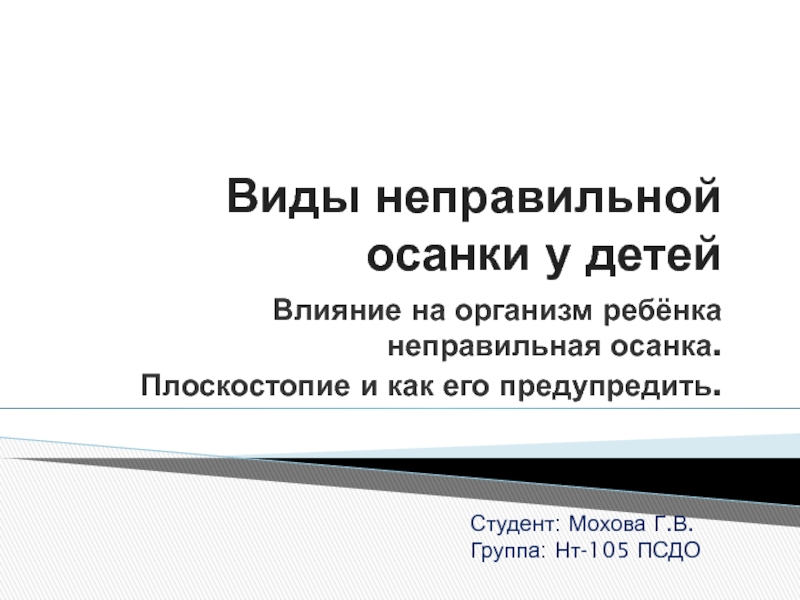Разделы презентаций
- Разное
- Английский язык
- Астрономия
- Алгебра
- Биология
- География
- Геометрия
- Детские презентации
- Информатика
- История
- Литература
- Математика
- Медицина
- Менеджмент
- Музыка
- МХК
- Немецкий язык
- ОБЖ
- Обществознание
- Окружающий мир
- Педагогика
- Русский язык
- Технология
- Физика
- Философия
- Химия
- Шаблоны, картинки для презентаций
- Экология
- Экономика
- Юриспруденция
Lecture 1
Содержание
- 1. Lecture 1
- 2. Compiled by I.A. Cheremisina HarrerCONTENTSDefinition of lexicologyApproaches
- 3. Compiled by I.A. Cheremisina HarrerTEST (1)1. How many words are there in English?10,000100,000250,000500,000
- 4. Compiled by I.A. Cheremisina HarrerTEST (2)2. Winston
- 5. Compiled by I.A. Cheremisina HarrerTEST (3)3. How
- 6. Compiled by I.A. Cheremisina HarrerTEST (4)4. How
- 7. Compiled by I.A. Cheremisina Harrer1. Definition of
- 8. Compiled by I.A. Cheremisina HarrerLexicon (then)Appeared in
- 9. Compiled by I.A. Cheremisina HarrerLexicon (now)Keeps the
- 10. Compiled by I.A. Cheremisina HarrerStudy of English
- 11. Compiled by I.A. Cheremisina HarrerLexicology (aims and
- 12. Compiled by I.A. Cheremisina HarrerGeneral lexicology The general
- 13. Compiled by I.A. Cheremisina HarrerSpecial lexicology Devotes its
- 14. Compiled by I.A. Cheremisina Harrer2. Approaches to
- 15. Compiled by I.A. Cheremisina HarrerThe synchronic approachis
- 16. Compiled by I.A. Cheremisina HarrerA course in
- 17. Compiled by I.A. Cheremisina HarrerThe diachronic approachin
- 18. Compiled by I.A. Cheremisina HarrerThe English historical
- 19. Compiled by I.A. Cheremisina HarrerDistinction between 2
- 20. Compiled by I.A. Cheremisina HarrerThe opposition of
- 21. Compiled by I.A. Cheremisina HarrerModern English lexicology Aims
- 22. Compiled by I.A. Cheremisina HarrerModern English lexicology
- 23. Compiled by I.A. Cheremisina Harrer3. Links with other branches of linguisticsLinguistic stylisticsSocial linguistics
- 24. Compiled by I.A. Cheremisina HarrerLinguistic stylisticsDeals with
- 25. Compiled by I.A. Cheremisina Harrer Girl-maiden-lass-chick-baby-young ladyGirl
- 26. Compiled by I.A. Cheremisina HarrerSocial linguisticsThe vocabulary
- 27. Compiled by I.A. Cheremisina HarrerThe extralinguistic causesAre
- 28. Compiled by I.A. Cheremisina HarrerExamplesJumbo jetSupersonic airlinerACV
- 29. Compiled by I.A. Cheremisina Harrer4. Branches of
- 30. Compiled by I.A. Cheremisina HarrerExamples of etymology:
- 31. Compiled by I.A. Cheremisina HarrerSalary and sausage
- 32. Compiled by I.A. Cheremisina HarrerMorphologyMorphology – study
- 33. Compiled by I.A. Cheremisina HarrerLexical morphologyStudies the
- 34. Compiled by I.A. Cheremisina HarrerInflectional morphology studies the
- 35. Compiled by I.A. Cheremisina HarrerSemantics Semantics – the
- 36. Compiled by I.A. Cheremisina HarrerOn the syntagmatic
- 37. Compiled by I.A. Cheremisina HarrerOn the paradigmatic
- 38. Compiled by I.A. Cheremisina HarrerSyntagmatic levelThe clock
- 39. Compiled by I.A. Cheremisina HarrerPhraseology Phraseology is the
- 40. Compiled by I.A. Cheremisina HarrerLexicography Lexicography is the
- 41. Compiled by I.A. Cheremisina Harrer Thank you for your attention! Any questions?!
- 42. Скачать презентанцию
Compiled by I.A. Cheremisina HarrerCONTENTSDefinition of lexicologyApproaches to language studyLinks with other branches of linguisticsBranches of lexicology
Слайды и текст этой презентации
Слайд 2Compiled by I.A. Cheremisina Harrer
CONTENTS
Definition of lexicology
Approaches to language study
Links
with other branches of linguistics
Слайд 3Compiled by I.A. Cheremisina Harrer
TEST (1)
1. How many words are
there in English?
10,000
100,000
250,000
500,000
Слайд 4Compiled by I.A. Cheremisina Harrer
TEST (2)
2. Winston Churchill was famous
for his particularly large vocabulary. How many words did he
use in his writing?10,000
60,000
100,000
120,000
Слайд 5Compiled by I.A. Cheremisina Harrer
TEST (3)
3. How many words does
the average native speaker use in his/her everyday speech?
2,500
5,000
7,500
10,000
Слайд 6Compiled by I.A. Cheremisina Harrer
TEST (4)
4. How many words make
up 45% of everything written in English?
50
250
1,000
2,500
Слайд 7Compiled by I.A. Cheremisina Harrer
1. Definition of lexicology
‘Lexis’ (of Greek
origin) = ‘word, phrase’
‘logos’ (of Greek origin) = ‘learning, branch
of knowledge’Lexicology – study of words
Слайд 8Compiled by I.A. Cheremisina Harrer
Lexicon (then)
Appeared in the 17th century
At
that time it referred to a book containing a selection
of language words and meanings, arranged in alphabetical order.Слайд 9Compiled by I.A. Cheremisina Harrer
Lexicon (now)
Keeps the original meaning
Has also
taken on a more abstract sense (within linguistics) – it
refers to the total stock of meaningful units (morphemes, words, word groups, idioms)Слайд 10Compiled by I.A. Cheremisina Harrer
Study of English lexicon
How words are
formed
How they have developed over time
How they are used now
How
they relate in meaning to each otherHow they are handled in dictionaries and other word books
Слайд 11Compiled by I.A. Cheremisina Harrer
Lexicology (aims and methods)
Study and systematic
description of vocabulary in respect to its origin, development and
current use.Слайд 12Compiled by I.A. Cheremisina Harrer
General lexicology
The general study of words
and vocabulary, irrespective of the specific features of any particular
language, is known as general lexicology.General theory of vocabulary.
Слайд 13Compiled by I.A. Cheremisina Harrer
Special lexicology
Devotes its attention to the
description of the characteristic peculiarities in the vocabulary of a
given language (e.g. English, Russian).Слайд 14Compiled by I.A. Cheremisina Harrer
2. Approaches to language study
Synchronic approach
Greek
syn ‘together, with’ and chronos ‘time’
Diachronic approach
Greek dia ‘through’
Слайд 15Compiled by I.A. Cheremisina Harrer
The synchronic approach
is concerned with the
vocabulary of a language as it exists at a given
time, for instance, at the present time.It is special descriptive lexicology that deals with the vocabulary and vocabulary units of a particular language at a certain time.
Слайд 16Compiled by I.A. Cheremisina Harrer
A course in modern English lexicology
is
therefore a course in special descriptive lexicology, its object of
study being the English vocabulary as it exists at the present time.Слайд 17Compiled by I.A. Cheremisina Harrer
The diachronic approach
in terms of special
lexicology deals with the changes and the development of vocabulary
in the course of time.Слайд 18Compiled by I.A. Cheremisina Harrer
The English historical lexicology
is concerned with
the origin of English vocabulary units,
their change and development,
the linguistic
and extralinguistic factors modifying their structure, meaning and usage within the history of English.Слайд 19Compiled by I.A. Cheremisina Harrer
Distinction between 2 approaches
Serves the purpose
of investigation what in real language is inseparable.
So the vocabulary
can be studied synchronically, i.e. in the context of the processes through which it grew, developed and acquired its modern form.Слайд 20Compiled by I.A. Cheremisina Harrer
The opposition of 2 approaches
is disputable
as the vocabulary (as well as the word) is NOT
only what it is NOW, at this particular stage of the language development, but, also, what it WAS centuries ago and HAS BEEN throughout the history.Слайд 21Compiled by I.A. Cheremisina Harrer
Modern English lexicology
Aims at giving a
systematic description of the word-stock of Modern English.
Слайд 22Compiled by I.A. Cheremisina Harrer
Modern English lexicology (2)
Investigates the problems
of word structure and word formation in Modern English, the
semantic structure of English words, principles of classifying words and ways of replenishment of the vocabulary.Слайд 23Compiled by I.A. Cheremisina Harrer
3. Links with other branches of
linguistics
Linguistic stylistics
Social linguistics
Слайд 24Compiled by I.A. Cheremisina Harrer
Linguistic stylistics
Deals with the study of
the nature, functions and structure of stylistic devices
And with the
investigation of each style of language, or register (its features and effect produced)Слайд 25Compiled by I.A. Cheremisina Harrer
Girl-maiden-lass-chick-baby-young lady
Girl –stylistically neutral, dominates the
row
Maiden – archaic and poetical word
Lass (ie) – dialectal word
Chick
& baby – slang wordsBaby – colloquial word
Young lady – ironical sense
Слайд 26Compiled by I.A. Cheremisina Harrer
Social linguistics
The vocabulary of a language
is never stable, never static, but is constantly changing, growing
and decaying.The changes in the vocabulary of a language are due both to linguistic and extralinguistic causes or to a combination of both.
Слайд 27Compiled by I.A. Cheremisina Harrer
The extralinguistic causes
Are determined by the
social nature of the language.
Changes in social life and developments
in science and technology are reflected in the language.Слайд 28Compiled by I.A. Cheremisina Harrer
Examples
Jumbo jet
Supersonic airliner
ACV – air cushion
vehicle
CEO – chief executive officer
O2 – phones 4u
Box, idiot box
(coll.)Couch potato, mouse potato
Слайд 29Compiled by I.A. Cheremisina Harrer
4. Branches of lexicology
Etymology - the
study of lexical history. It investigates the origins of individual
lexemes, the affinities they have had to each other, and how they have changed in meaning and in form to reach their present state.Слайд 30Compiled by I.A. Cheremisina Harrer
Examples of etymology: sly
Sly – the
word came into Middle English from Scandinavian, where the dominant
meaning was ‘cunning’, with its implication of special knowledge of wisdom.Sly is also referred to sleight ‘dexterity’ and slay originally meant ‘dexterous with hammer’
Слайд 31Compiled by I.A. Cheremisina Harrer
Salary and sausage (origin)
Salary came into
English via French from Latin, where salarium meant ‘salt-money’ (given
to the soldiers to buy salt)Sausage also came via French from Latin, where salsicium was smth made from salted meat. Salt is the common element, seen also in sauce and salad.
Слайд 32Compiled by I.A. Cheremisina Harrer
Morphology
Morphology – study of the structure
of words.
Morphology is divided into 2 domains: lexical (or derivational)
morphology and inflectional (or grammatical morphology).Слайд 33Compiled by I.A. Cheremisina Harrer
Lexical morphology
Studies the way in which
new items of vocabulary can be built up out of
combinations of elements as inin-describ-able
un-forgett-able
tele-scop-ic
Слайд 34Compiled by I.A. Cheremisina Harrer
Inflectional morphology
studies the way words vary
in their form in order to express a grammatical contrast
(as in the case of horses where the ending marks plurality) or where the ending marks the 3rd person singular form of the verbe.g. do-does, speak-speaks
Слайд 35Compiled by I.A. Cheremisina Harrer
Semantics
Semantics – the study of meaning.
Modern
approaches are characterized by 2 different levels of study: syntagmatic
and paradigmatic.Слайд 36Compiled by I.A. Cheremisina Harrer
On the syntagmatic level
The semantic structure
of the word is analyzed in its linear relationships with
neighboring words in connected speech.Therefore, the semantic characteristics of the word are observed, described and studied on the basis of its typical contexts, i.e. semantics studies combinability or collocability of words.
Слайд 37Compiled by I.A. Cheremisina Harrer
On the paradigmatic level
the word is
studied in its relationships with other words in the vocabulary
system.So, a word may be studied in comparison with other words of similar meaning, of opposite meaning, of different stylistic characteristics.
Слайд 38Compiled by I.A. Cheremisina Harrer
Syntagmatic level
The clock on the wall
had just chimed midnight when the portrait hole burst open.
The
kick-off meeting went smoothly.MPs are likely to express extreme views.
Check properly what you have written and then send it off.
Слайд 39Compiled by I.A. Cheremisina Harrer
Phraseology
Phraseology is the branch of lexicology
specializing in word groups which are characterized by stability of
structure and transferred meaning.e.g. To show the white feather (струсить)
To hit the headlines (оказаться в новостях)
at first hand (из первых рук)
